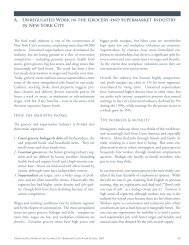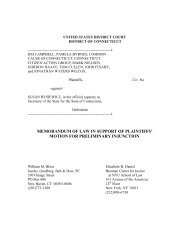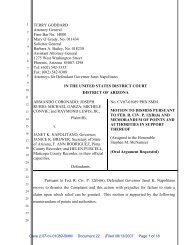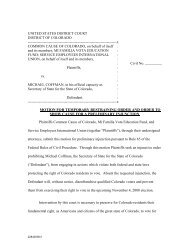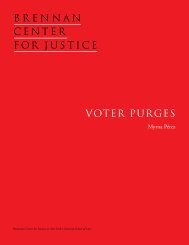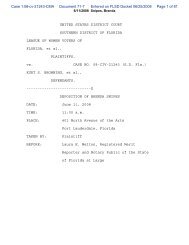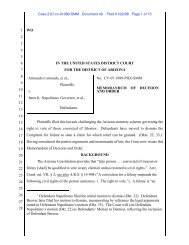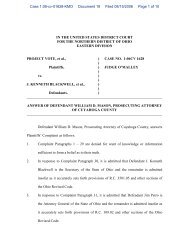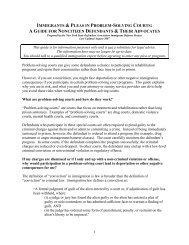Sequoia identified four possible causes <strong>for</strong> the problem, including a transient malfunction of thememory pack reader, which transmits in<strong>for</strong>mation from the memory cartridge to the tally database,but stated that the voting system event logs would not record any of the possible malfunctions, “makingit impossible to provide a more definitive answer.” 152Nine days after the September primary, the D.C. Council subpoenaed in<strong>for</strong>mation about the votingmachines’ source code from Sequoia so that it could conduct a more thorough investigation. 153According to the Washington Post, Sequoia objected to this request on the grounds that it constitutedtrade secrets or otherwise protected material. 154 The vendor also objected to the Council’s request <strong>for</strong> alldocuments related to any irregularities in similar voting systems, stating that it had no documentationof such incidents. 155The Post reported that when the Council persisted in its attempts to get the in<strong>for</strong>mation, the company asked<strong>for</strong> a $20 million bond to guarantee confidentiality. 156 According to board officials, the company still hadnot responded to the subpoena as of late April 2009. 157 In April, theCouncil filed a motion in the District of Columbia Superior Courtto attempt to <strong>for</strong>ce the company to comply with the subpoena.“as it is now, there’s little158On June 5, under a protective order from a Superior Court Judge,communication between Sequoia agreed to release the source code <strong>for</strong> the voting system. 159When news of the agreement broke, Councilwoman Mary Chehjurisdictions, so vendors said, “they fought us tooth and nail until now.” 160hold all the cards.”The findings of the District of Columbia investigation will soondistrict of columbiabe made public. In the interim, the Council passed electionre<strong>for</strong>m legislation that includes a ‘warranty provision’ requiringcouncilmember mary cheh any vendor that sells voting systems to the District to “[p]romptlyand fully disclose any flaw, defect, or vulnerability in the votingsystem of which the vendor is aware or becomes aware” and toremedy the problem appropriately. 161While this bill will help D.C. election officials get needed in<strong>for</strong>mation about voting system defects inthe future, Councilmember Mary Cheh still sees a need <strong>for</strong> a centralized, national database. “It wasdifficult <strong>for</strong> us to get the in<strong>for</strong>mation we needed in D.C. If we were in a smaller, more fragmented, orpolitically divided jurisdiction, it would have been even harder <strong>for</strong> us to get necessary in<strong>for</strong>mation inan expeditious fashion,” said Cheh. “As it is now, there’s little communication between jurisdictions, sovendors hold all the cards.” 16213. New Jersey, February 2008• • •According to a public records request <strong>for</strong> results obtained by researchers at Princeton University,thirty-eight Sequoia AVC Advantage DRE voting machines in eight New Jersey counties experiencedanomalies during the February 5, 2008 primary election. 163 A county official initially discovered theproblem by comparing machine counter totals with the paper printouts produced by the machines atthe close of the polls. 164 The county alerted other counties, which do not routinely reconcile these twototals, to the potential malfunction. 165 The Times of Trenton reported that the problem initially appeared22 | Brennan Center <strong>for</strong> Justice
to be with the turnout totals – while all votes seemed to be correctly recorded, the total number ofindividuals who cast votes <strong>for</strong> each party appeared to be slightly off. 166 Sequoia inspected the equipmentand concluded that the problem was poll worker error, not equipment malfunction. 167 In early March,the company issued a technical bulletin advising users of the machine on how to protect against thiserror in the future. 168In March, several counties decided to enlist a team of Princeton computer scientists to conduct anindependent study on the equipment used in the February primary. After the counties’ intent to handover their voting machines <strong>for</strong> assessment became known, one of the researchers who was set to conductthe analysis reported on his blog that he received an e-mail from Sequoia stating that the companywill “take appropriate steps to protect against any publication of Sequoia software, its behavior, reportsregarding the same, or any other infringement of [its] intellectual property.” 169 The Star-Ledger reportedthat at least one county which subsequently backed the ef<strong>for</strong>t received a letter from Sequoia statingthat conducting an independent investigation would violate the licensing agreement between thevendor and the county, and threatening to sue if the county proceeded with the inquiry. 170 In addition,that same month, advocates at the Rutgers Constitutional Litigation Clinic issued a subpoena <strong>for</strong> thenecessary in<strong>for</strong>mation to conduct an independent analysis, including the machines’ source code, buildtools, operator manuals, and maintenance manuals. 171 According to the Princeton researchers’ finalreport, Sequoia “vigorously protested” sharing its source code on grounds of defending its intellectualproperty and it took “months of litigation” to negotiate a protective order under which Sequoia wouldshare the in<strong>for</strong>mation. 172 In May, a Superior Courtjudge issued a protective order permitting the teamof Princeton researchers to examine two of the DREs officials in montgomery county,used in the February primary but preventing thedisclosure of “any conclusions or comments” about pennsylvania, an avc advantagethe machines resulting from the investigation. 173county located less than fifty milesIn June, after the plaintiffs who issued the subpoenafrom the new jersey border, toldand researchers conducting the assessment refusedto sign the protective order on the grounds that it the philadelphia inquirer that theyviolated their speech rights and academic freedom,the judge who issued the initial protective order were unaware of the problems thatreversed her ruling with respect to the non-disclosurehad occurred in new jersey.of the researchers’ findings. 174 The results of thereleased independent analysis showed the researchersconcluded that on all but one of the thirty-eight machines that malfunctioned during the primary, thenumber of votes <strong>for</strong> candidates of a certain party exceeded the number of individuals who voted on thatparty’s ballot. 175 Some machines logged more votes <strong>for</strong> Democrats than Democratic voters, and otherslogged more votes <strong>for</strong> Republicans than the number of Republican voters. 176 The researchers concludedthat it would be “easy and natural” <strong>for</strong> poll workers to make the mistake that triggered the programmingerror that produced incorrect vote totals. Some voters were effectively disenfranchised by this error. Thosewho received the wrong party’s ballot could not choose a candidate of their own party as was their legalright, and write-in votes <strong>for</strong> their chosen party were not counted because it is unlawful <strong>for</strong> a voter to votein the primary election of a party to which she does not belong. 177 Furthermore, the researchers identifiedserious insecurities in the machines, and stated that the machines could be quickly and imperceptiblyhacked to steal votes by anyone with “only ordinary training” in computer science. 178Brennan Center <strong>for</strong> Justice | 23
- Page 5: IV.A BETTER WAY TO TRACK AND ADDRES
- Page 11: 4. Pressure Vendors to Voluntarily
- Page 14 and 15: its newly established Voting System
- Page 16 and 17: iii.failures of the current system:
- Page 18 and 19: 2. Humboldt County, California, Nov
- Page 20 and 21: 4. Pulaski County, Arkansas, May 20
- Page 22 and 23: 7. Florida, June 2004According to t
- Page 24 and 25: Denise Lamb, who currently serves a
- Page 26 and 27: Ms. Poucher has stated that it “w
- Page 30 and 31: Had advocates and researchers in Ne
- Page 32 and 33: elative to voting system vendors. A
- Page 34 and 35: or potential vulnerabilities by any
- Page 36 and 37: Finally, the Department of Justice
- Page 38 and 39: Provide Timely & Organized Access t
- Page 40 and 41: the CPSC may compel the manufacture
- Page 42 and 43: Civil Division of the Department of
- Page 44 and 45: C. Analogous RegimesCivil penalty p
- Page 46 and 47: Of course, adding these kinds of pr
- Page 49 and 50: v. conclusionVoting is the most imp
- Page 51 and 52: System Vulnerabilities: should incl
- Page 53 and 54: February2008September2004November20
- Page 55 and 56: November2006November2006ES&SiVotron
- Page 57 and 58: June 2008SequoiaOptech 400CCaliforn
- Page 59 and 60: March 2004March 2004DieboldAccuVote
- Page 61 and 62: February2008September2008PremierAcc
- Page 63 and 64: event of an overvote displayed a co
- Page 67 and 68: January 2008January 2008PremierAccu
- Page 69 and 70: November2004ES&SM650FloridaSupervis
- Page 71 and 72: October 2008February2008PremierAccu
- Page 73 and 74: February2008February2008October 200
- Page 75 and 76: 2004 AccuVote 2000ESNovember2008Nov
- Page 77 and 78: November2008November2008Hart InterC
- Page 79 and 80:
February2008May 2006August 2004May2
- Page 81 and 82:
March 2008June 2009November2008Prem
- Page 83 and 84:
February2008November2006SequoiaAVC
- Page 85 and 86:
November2008SequoiaImageCastNew Yor
- Page 87 and 88:
November2004November2004UnilectPatr
- Page 89 and 90:
November2008November2008March 2008E
- Page 91 and 92:
May 2008April 2008November2006May 2
- Page 93 and 94:
2006 iVotronicThe Post & Courier re
- Page 95 and 96:
AccuVote TSR6; HartInterCiviceScan;
- Page 97 and 98:
November2006ES&S:iVotronicTexasHida
- Page 99 and 100:
November2003November2009November200
- Page 101 and 102:
October 2008October 2008May 2008ES&
- Page 103 and 104:
appendix c : dupage county election
- Page 105 and 106:
and resolve problems with certified
- Page 107 and 108:
49. E-mail from Carolyn Crnich, Cle
- Page 109 and 110:
95. Kleinberg, supra note 92.96. Ma
- Page 111 and 112:
143. Telephone Interview with Rokey
- Page 113 and 114:
187. Id. at 22.188. See Thomas, sup
- Page 115 and 116:
1801 (“[T]he Secretary shall init
- Page 117 and 118:
258. See United States Department o
- Page 119 and 120:
294. John Archibald & Brett J. Blac
- Page 121 and 122:
334. Jane Musgrave, Palm Beach Coun
- Page 123 and 124:
374. Glitch Keeps Fulton Voters Wai
- Page 125 and 126:
417. Joe Dejka & Chris Olson, A Lat
- Page 127 and 128:
457. Letter from Dave Byrd, Preside
- Page 129:
498. Lauren Glendenning, Voting Gli
- Page 132:
ennancenterfor justiceAt New York U


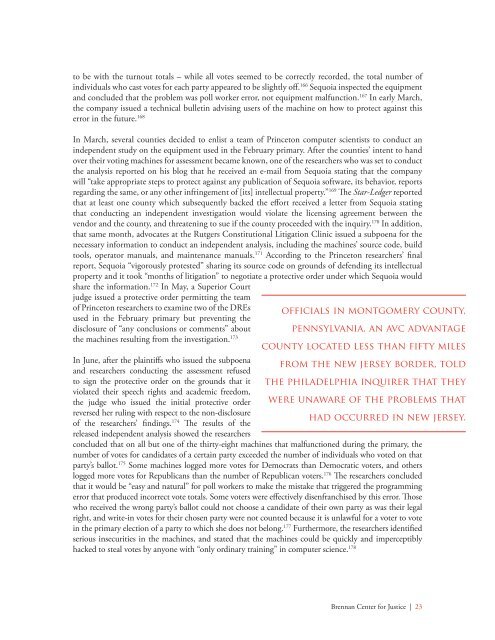
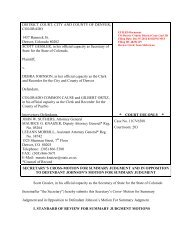
![Download the Letter [PDF] - Brennan Center for Justice](https://img.yumpu.com/50139248/1/190x245/download-the-letter-pdf-brennan-center-for-justice.jpg?quality=85)
